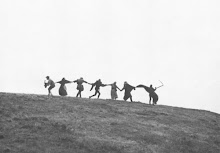 Guy Fawkes was a professional soldier, forever famous for his involvement in a plot to blow up the House of Lords in London. Although it is his name that is synonymous with the events, he was not the mastermind; that was someone else. But Fawkes was the first to be discovered, and something about him caught the public imagination.
Guy Fawkes was a professional soldier, forever famous for his involvement in a plot to blow up the House of Lords in London. Although it is his name that is synonymous with the events, he was not the mastermind; that was someone else. But Fawkes was the first to be discovered, and something about him caught the public imagination. Fawkes was a Catholic at a time when England's Catholics were feverishly dreaming of a national return to the Church of Rome. It was rather unpopular to be Catholic at the time, there were a lot of rules about open practice of the Faith and a great deal of informal social prejudice. Fawkes kept quiet about his convictions and spent as much time as possible out of the country. As a professional soldier he had many opportunities to do so.
The staunchly Protestant James I (the Scottish king who had succeeded Queen Elizabeth only three years previously) was seen by Catholics as the biggest obstacle to the glorious return to true Christendom. A small group of conspirators decided that by blowing up the House of Lords, with James and his family and most of the aristocracy inside, they would initiate a general uprising across the country, supported of course by foreign troops arriving from the continent. Fawkes was put in charge of the practical details of executing the plot because of his experience as a soldier. Under his management, they rented a cellar under the House of Lords and began surreptitiously filling it with vast quantities of gunpowder and firewood.
Unfortunately for the group, some of them had consciences, or a partial consciences anyway: they were concerned about the few Catholics who would be present at the opening of Parliament. One went so far as to write an anonymous letter of warning to Lord Monteagle, who promptly took it to the authorities. At least, that was his story. Many believe today that he found out about the plot through his own Catholic connections, and concocted the "anonymous" letter himself in order to gain credit for the discovery and distance himself from the conspirators.
In the early morning of November 5 he and another Lord searched the vaults under Parliament, aided by a band of stout constables, and discovered "tall and desperate fellow" skulking around — Fawkes himself, disguised as a servant. They seized and bound him. The other conspirators quickly heard of the arrest and fled London, vainly trying to raise mobs of angry Catholic sympathisers along the way.
Meanwhile, back in London, Fawkes was being tortured for information. He was very strong, calm, and a fanatical idealist; he held out for several days (earning the respect of his torturers and even the King in the process). It was only when he learned that his co-conspirators had revealed themselves by publicly taking up arms that he began to talk, but even then gave only the names that were already known or of those already dead. By this time, it was a formality. Most of the details of the plot were known, and everyone remotely involved in it had been arrested.
Fawkes was sentenced to be hung, drawn, and quartered on January 31, 1606, along with three other conspirators (four others had already been executed). Visibly "weak with torture and sickness" he asked forgiveness of the King and state, but maintained his Catholic faith to the end. He was barely able to mount the ladder to the scaffold, and had to be helped up by the hangman. He was able, however, to mount high enough and then leap from the scaffold, breaking his neck and dying before being taken to the quartering table.
Under the public outrage against Fawkes, which was considerable, there was always a sneaking admiration, that has come more and more to the surface, the more time passes. To this day November 5 (the date of the discovery of the plot) is Bonfire Night, when children put together an effigy of Fawkes and then burn him. But he was also voted #30 in the BBC-sponsored list of "100 Greatest Britons" in 2002. In 2006 the film V for Vendetta, set in a future British dystopia, had the mysterious protagonist take Guy Fawkes as his historical inspiration. It includes a re-enactment of his capture and execution. Kinda fun (as these things go).
Sources: Wikipedia; Fraser, Antonia, Faith and Treason, Weidenfeld and Nicolson, 1996




































